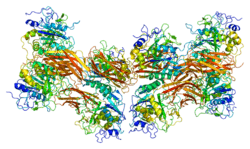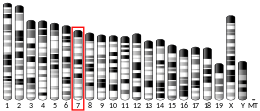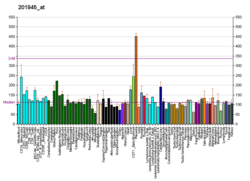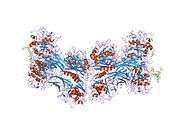Furin
Furin is an enzyme that in humans is encoded by the FURIN gene. Some proteins are inactive when they are first synthesized, and must have sections removed in order to become active. Furin cleaves these sections and activates the proteins.[5][6][7][8] It was named furin because it was in the upstream region of an oncogene known as FES. The gene was known as FUR (FES Upstream Region) and therefore the protein was named furin. Furin is also known as PACE (Paired basic Amino acid Cleaving Enzyme). A member of family S8, furin is a subtilisin-like peptidase.
Function
The protein encoded by this gene is an enzyme that belongs to the subtilisin-like proprotein convertase family. The members of this family are proprotein convertases that process latent precursor proteins into their biologically active products. This encoded protein is a calcium-dependent serine endoprotease that can efficiently cleave precursor proteins at their paired basic amino acid processing sites. Some of its substrates are: proparathyroid hormone, transforming growth factor beta 1 precursor, proalbumin, pro-beta-secretase, membrane type-1 matrix metalloproteinase, beta subunit of pro-nerve growth factor and von Willebrand factor. A furin-like pro-protein convertase has been implicated in the processing of RGMc (also called hemojuvelin), a gene involved in a severe iron-overload disorder called juvenile hemochromatosis. Both the Ganz and Rotwein groups demonstrated that furin-like proprotein convertases (PPC) are responsible for conversion of 50 kDa HJV to a 40 kDa protein with a truncated COOH-terminus, at a conserved polybasic RNRR site. This suggests a potential mechanism to generate the soluble forms of HJV/hemojuvelin (s-hemojuvelin) found in the blood of rodents and humans.[9][10]
Furin is one of the proteases responsible for the proteolytic cleavage of HIV envelope polyprotein precursor gp160 to gp120 and gp41 prior to viral assembly.[11] This gene is thought to play a role in tumor progression. The use of alternate polyadenylation sites has been found for this gene.[7]
Furin is enriched in the Golgi apparatus, where it functions to cleave other proteins into their mature/active forms.[12] Furin cleaves proteins just downstream of a basic amino acid target sequence (canonically, Arg-X-(Arg/Lys) -Arg'). In addition to processing cellular precursor proteins, furin is also utilized by a number of pathogens. For example, the envelope proteins of viruses such as HIV, influenza, dengue fever, several filoviruses including ebola and marburg virus, and possibly the spike protein of SARS-CoV-2,[13] must be cleaved by furin or furin-like proteases to become fully functional. Anthrax toxin, pseudomonas exotoxin, and papillomaviruses must be processed by furin during their initial entry into host cells. Inhibitors of furin are under consideration as therapeutic agents for treating anthrax infection.[14]
Furin is regulated by cholesterol and substrate presentation. When cholesterol is high, furin traffics to GM1 lipid rafts. When cholesterol is low, furin traffics to the disordered region[15]. This is speculated to contribute to cholesterol and age dependent priming of SARS-CoV.
The furin substrates and the locations of furin cleavage sites in protein sequences can be predicted by two bioinformatics methods: ProP [16] and PiTou.[17]
Expression of furin in T-cells is required for maintenance of peripheral immune tolerance.[18]
References
- GRCh38: Ensembl release 89: ENSG00000140564 - Ensembl, May 2017
- GRCm38: Ensembl release 89: ENSMUSG00000030530 - Ensembl, May 2017
- "Human PubMed Reference:". National Center for Biotechnology Information, U.S. National Library of Medicine.
- "Mouse PubMed Reference:". National Center for Biotechnology Information, U.S. National Library of Medicine.
- Wise RJ, Barr PJ, Wong PA, Kiefer MC, Brake AJ, Kaufman RJ (Dec 1990). "Expression of a human proprotein processing enzyme: correct cleavage of the von Willebrand factor precursor at a paired basic amino acid site". Proceedings of the National Academy of Sciences of the United States of America. 87 (23): 9378–82. doi:10.1073/pnas.87.23.9378. PMC 55168. PMID 2251280.
- Kiefer MC, Tucker JE, Joh R, Landsberg KE, Saltman D, Barr PJ (Dec 1991). "Identification of a second human subtilisin-like protease gene in the fes/fps region of chromosome 15". DNA and Cell Biology. 10 (10): 757–69. doi:10.1089/dna.1991.10.757. PMID 1741956.
- "Entrez Gene: FURIN furin (paired basic amino acid cleaving enzyme)".
- Roebroek AJ, Schalken JA, Leunissen JA, Onnekink C, Bloemers HP, Van de Ven WJ (Sep 1986). "Evolutionary conserved close linkage of the c-fes/fps proto-oncogene and genetic sequences encoding a receptor-like protein". The EMBO Journal. 5 (9): 2197–202. PMC 1167100. PMID 3023061.
- Lin L, Nemeth E, Goodnough JB, Thapa DR, Gabayan V, Ganz T (2008). "Soluble hemojuvelin is released by proprotein convertase-mediated cleavage at a conserved polybasic RNRR site". Blood Cells, Molecules & Diseases. 40 (1): 122–31. doi:10.1016/j.bcmd.2007.06.023. PMC 2211380. PMID 17869549.
- Kuninger D, Kuns-Hashimoto R, Nili M, Rotwein P (2008). "Pro-protein convertases control the maturation and processing of the iron-regulatory protein, RGMc/hemojuvelin". BMC Biochemistry. 9: 9. doi:10.1186/1471-2091-9-9. PMC 2323002. PMID 18384687.
- Hallenberger S, Bosch V, Angliker H, Shaw E, Klenk HD, Garten W (Nov 1992). "Inhibition of furin-mediated cleavage activation of HIV-1 glycoprotein gp160". Nature. 360 (6402): 358–61. doi:10.1038/360358a0. PMID 1360148.
- Thomas G (Oct 2002). "Furin at the cutting edge: from protein traffic to embryogenesis and disease". Nature Reviews Molecular Cell Biology. 3 (10): 753–66. doi:10.1038/nrm934. PMC 1964754. PMID 12360192.
- Coutard B, Valle C, de Lamballerie X, Canard B, Seidah NG, Decroly E (February 2020). "The spike glycoprotein of the new coronavirus 2019-nCoV contains a furin-like cleavage site absent in CoV of the same clade". Antiviral Research. 176: 104742. doi:10.1016/j.antiviral.2020.104742. PMID 32057769.
- Shiryaev SA, Remacle AG, Ratnikov BI, Nelson NA, Savinov AY, Wei G, Bottini M, Rega MF, Parent A, Desjardins R, Fugere M, Day R, Sabet M, Pellecchia M, Liddington RC, Smith JW, Mustelin T, Guiney DG, Lebl M, Strongin AY (Jul 2007). "Targeting host cell furin proprotein convertases as a therapeutic strategy against bacterial toxins and viral pathogens". The Journal of Biological Chemistry. 282 (29): 20847–53. doi:10.1074/jbc.M703847200. PMID 17537721.
- Wang, Hao; Yuan, Zixuan; Pavel, Mahmud Arif; Hansen, Scott B. (29 May 2020). "The role of high cholesterol in age-related COVID19 lethality". bioRxiv: 2020.05.09.086249. doi:10.1101/2020.05.09.086249.
- Duckert P, Brunak S, Blom N (Jan 2004). "Prediction of proprotein convertase cleavage sites". Protein Engineering, Design & Selection. 17 (1): 107–112. doi:10.1093/protein/gzh013. PMID 14985543.
- Tian S, Huajun W, Wu J (February 2012). "Computational prediction of furin cleavage sites by a hybrid method and understanding mechanism underlying diseases". Scientific Reports. 2. doi:10.1038/srep00261. PMC 3281273. PMID 22355773.
- Pesu M, Watford WT, Wei L, Xu L, Fuss I, Strober W, Andersson J, Shevach EM, Quezado M, Bouladoux N, Roebroek A, Belkaid Y, Creemers J, O'Shea JJ (Sep 2008). "T-cell-expressed proprotein convertase furin is essential for maintenance of peripheral immune tolerance". Nature. 455 (7210): 246–50. doi:10.1038/nature07210. PMC 2758057. PMID 18701887.
- Wan L, Molloy SS, Thomas L, Liu G, Xiang Y, Rybak SL, Thomas G (Jul 1998). "PACS-1 defines a novel gene family of cytosolic sorting proteins required for trans-Golgi network localization". Cell. 94 (2): 205–16. doi:10.1016/S0092-8674(00)81420-8. PMID 9695949.
Further reading
- Nakayama K (Nov 1997). "Furin: a mammalian subtilisin/Kex2p-like endoprotease involved in processing of a wide variety of precursor proteins". The Biochemical Journal. 327 (3): 625–35. doi:10.1042/bj3270625. PMC 1218878. PMID 9599222.
- Bassi DE, Mahloogi H, Klein-Szanto AJ (Jun 2000). "The proprotein convertases furin and PACE4 play a significant role in tumor progression". Molecular Carcinogenesis. 28 (2): 63–9. doi:10.1002/1098-2744(200006)28:2<63::AID-MC1>3.0.CO;2-C. PMID 10900462.
- Hallenberger S, Bosch V, Angliker H, Shaw E, Klenk HD, Garten W (Nov 1992). "Inhibition of furin-mediated cleavage activation of HIV-1 glycoprotein gp160". Nature. 360 (6402): 358–61. doi:10.1038/360358a0. PMID 1360148.
- Rehemtulla A, Kaufman RJ (May 1992). "Preferred sequence requirements for cleavage of pro-von Willebrand factor by propeptide-processing enzymes". Blood. 79 (9): 2349–55. PMID 1571548.
- Leduc R, Molloy SS, Thorne BA, Thomas G (Jul 1992). "Activation of human furin precursor processing endoprotease occurs by an intramolecular autoproteolytic cleavage". The Journal of Biological Chemistry. 267 (20): 14304–8. PMID 1629222.
- Barr PJ, Mason OB, Landsberg KE, Wong PA, Kiefer MC, Brake AJ (Jun 1991). "cDNA and gene structure for a human subtilisin-like protease with cleavage specificity for paired basic amino acid residues". DNA and Cell Biology. 10 (5): 319–28. doi:10.1089/dna.1991.10.319. PMID 1713771.
- Herz J, Kowal RC, Goldstein JL, Brown MS (Jun 1990). "Proteolytic processing of the 600 kd low density lipoprotein receptor-related protein (LRP) occurs in a trans-Golgi compartment". The EMBO Journal. 9 (6): 1769–76. PMC 551881. PMID 2112085.
- van den Ouweland AM, van Duijnhoven HL, Keizer GD, Dorssers LC, Van de Ven WJ (Feb 1990). "Structural homology between the human fur gene product and the subtilisin-like protease encoded by yeast KEX2". Nucleic Acids Research. 18 (3): 664. doi:10.1093/nar/18.3.664. PMC 333486. PMID 2408021.
- Van den Ouweland AM, Van Groningen JJ, Roebroek AJ, Onnekink C, Van de Ven WJ (Sep 1989). "Nucleotide sequence analysis of the human fur gene". Nucleic Acids Research. 17 (17): 7101–2. doi:10.1093/nar/17.17.7101. PMC 318436. PMID 2674906.
- Roebroek AJ, Schalken JA, Leunissen JA, Onnekink C, Bloemers HP, Van de Ven WJ (Sep 1986). "Evolutionary conserved close linkage of the c-fes/fps proto-oncogene and genetic sequences encoding a receptor-like protein". The EMBO Journal. 5 (9): 2197–202. PMC 1167100. PMID 3023061.
- Molloy SS, Thomas L, VanSlyke JK, Stenberg PE, Thomas G (Jan 1994). "Intracellular trafficking and activation of the furin proprotein convertase: localization to the TGN and recycling from the cell surface". The EMBO Journal. 13 (1): 18–33. PMC 394775. PMID 7508380.
- Brakch N, Dettin M, Scarinci C, Seidah NG, Di Bello C (Aug 1995). "Structural investigation and kinetic characterization of potential cleavage sites of HIV GP160 by human furin and PC1". Biochemical and Biophysical Research Communications. 213 (1): 356–61. doi:10.1006/bbrc.1995.2137. PMID 7639757.
- Takahashi S, Kasai K, Hatsuzawa K, Kitamura N, Misumi Y, Ikehara Y, Murakami K, Nakayama K (Sep 1993). "A mutation of furin causes the lack of precursor-processing activity in human colon carcinoma LoVo cells". Biochemical and Biophysical Research Communications. 195 (2): 1019–26. doi:10.1006/bbrc.1993.2146. PMID 7690548.
- Hendy GN, Bennett HP, Gibbs BF, Lazure C, Day R, Seidah NG (Apr 1995). "Proparathyroid hormone is preferentially cleaved to parathyroid hormone by the prohormone convertase furin. A mass spectrometric study". The Journal of Biological Chemistry. 270 (16): 9517–25. doi:10.1074/jbc.270.16.9517. PMID 7721880.
- Dubois CM, Laprise MH, Blanchette F, Gentry LE, Leduc R (May 1995). "Processing of transforming growth factor beta 1 precursor by human furin convertase". The Journal of Biological Chemistry. 270 (18): 10618–24. doi:10.1074/jbc.270.18.10618. PMID 7737999.
- Gu M, Rappaport J, Leppla SH (May 1995). "Furin is important but not essential for the proteolytic maturation of gp160 of HIV-1". FEBS Letters. 365 (1): 95–7. doi:10.1016/0014-5793(95)00447-H. PMID 7774724.
- Schäfer W, Stroh A, Berghöfer S, Seiler J, Vey M, Kruse ML, Kern HF, Klenk HD, Garten W (Jun 1995). "Two independent targeting signals in the cytoplasmic domain determine trans-Golgi network localization and endosomal trafficking of the proprotein convertase furin". The EMBO Journal. 14 (11): 2424–35. PMC 398356. PMID 7781597.
- Mbikay M, Seidah NG, Chrétien M, Simpson EM (Mar 1995). "Chromosomal assignment of the genes for proprotein convertases PC4, PC5, and PACE 4 in mouse and human". Genomics. 26 (1): 123–9. doi:10.1016/0888-7543(95)80090-9. PMID 7782070.






